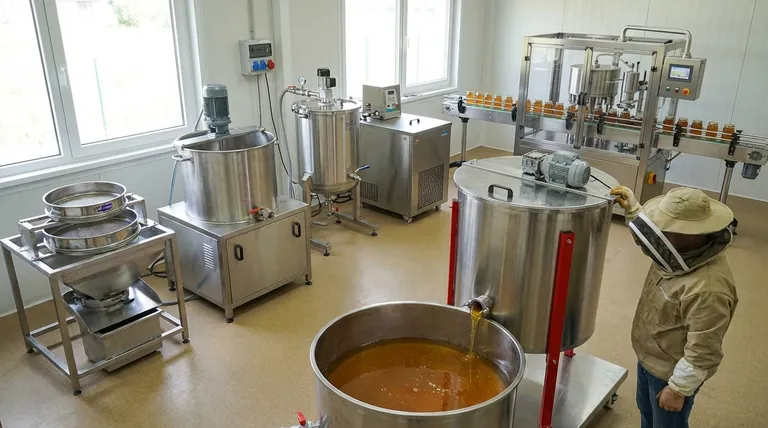The primary steps in honey processing are extraction, coarse filtration, preheating and agitation, fine filtration, low-temperature concentration to control moisture, and finally, filling and packaging. This systematic workflow is designed to transform raw honey from the comb into a stable, pure, and marketable product while preserving its essential qualities.
The core objective of the honey processing workflow is to remove physical impurities like wax and debris and to reduce water content to prevent fermentation, ensuring a high-quality, shelf-stable product.

The Honey Processing Workflow: A Step-by-Step Breakdown
Each stage in the honey processing workflow serves a distinct purpose, moving the product from its raw state to a finished good ready for consumption. The process relies on a combination of mechanical force, gentle heat, and filtration.
Step 1: Extraction - From Comb to Liquid
The process begins with extraction, where honey is removed from the honeycomb. This is typically accomplished using a honey extractor, a machine that uses centrifugal force to spin the honey out of the uncapped comb cells without destroying the comb itself.
Step 2: Coarse Filtration - Removing Large Debris
Once extracted, the raw honey passes through a coarse filtration system. The primary goal here is to remove large, visible impurities such as bits of beeswax, wood from the frames, and other debris that may have been collected during extraction.
Step 3: Agitation and Preheating - Preparing for Finer Processing
To flow more easily through the system, the honey is often gently preheated. A heating element warms the honey slightly, lowering its viscosity. This step is frequently combined with agitation or homogenization to ensure the batch has a uniform texture and temperature.
Step 4: Fine Filtration - Achieving Clarity
After preheating, the honey undergoes fine filtration. This step removes smaller suspended particles, including fine wax particles and air bubbles, resulting in a clearer and more visually appealing final product.
Step 5: Low-Temperature Concentration - Controlling Moisture
One of the most critical steps is low-temperature concentration. This process reduces the honey's natural water content. Lowering the moisture level is essential for preventing fermentation and crystallization, thereby extending the honey's shelf life significantly.
Step 6: Filling and Packaging - The Final Stage
The final stage involves an automated packaging unit. The processed honey is carefully filled into jars or other containers, sealed, and labeled for distribution and sale.
Understanding the Trade-offs: Heat and Filtration
While the workflow is straightforward, the quality of the final product depends on carefully managing the key variables of heat and filtration. Mismanagement here can degrade the honey's natural characteristics.
The Double-Edged Sword of Heat
Heat is necessary to make honey fluid enough for efficient filtration and packaging. However, excessive heat is the enemy of high-quality honey. Overheating can destroy the natural enzymes and delicate aromas that define the product's character and nutritional value. The key is applying gentle, controlled heat just sufficient for processing.
The Filtration Dilemma: Purity vs. Pollen
Filtration creates a clear, pure product that many consumers expect. However, extremely fine filtration can remove beneficial components like pollen. Since pollen grains are a key indicator of honey's floral source, some consumers prefer less-filtered honey, often marketed as "raw," which retains these elements.
Making the Right Choice for Your Goal
The ideal processing method depends entirely on the intended final product and target market.
- If your primary focus is large-scale commercial distribution: A complete workflow with controlled heating, fine filtration, and moisture reduction is essential to ensure shelf stability and a consistent product.
- If your primary focus is producing artisanal or "raw" honey: Minimize heat application at all stages and use only coarse filtration to retain natural enzymes, pollen, and a more robust flavor profile.
Ultimately, a well-managed honey processing workflow balances the need for purity and stability with the goal of preserving the honey's unique natural qualities.
Summary Table:
| Step | Process | Key Purpose |
|---|---|---|
| 1 | Extraction | Remove honey from comb using centrifugal force. |
| 2 | Coarse Filtration | Eliminate large debris like wax and wood. |
| 3 | Agitation & Preheating | Lower viscosity for uniform texture and easier flow. |
| 4 | Fine Filtration | Remove fine particles and air bubbles for clarity. |
| 5 | Low-Temp Concentration | Reduce moisture to prevent fermentation. |
| 6 | Filling & Packaging | Automatically fill, seal, and label for market. |
Ready to Optimize Your Honey Processing Workflow?
Whether you're a commercial apiary aiming for large-scale consistency or a distributor seeking reliable equipment, HONESTBEE has the solutions. We supply the durable, high-performance beekeeping supplies and equipment you need to execute every step of the honey processing workflow efficiently.
Contact our experts today to discuss how our wholesale-focused operations can support your business goals with the right tools for extraction, filtration, and packaging.
Visual Guide

Related Products
- 8-Frame Electric Self-Reversing Honey Extractor Spinner for Commercial Honey Extraction Equipment
- electric honey extractor honey centrifuge 3 frame honey extractor stainless steel honey frame extractor
- Electric 8 Frame Honey Spinner Extractor Equipment for Beekeeping
- HONESTBEE 72 Frame Industrial Electric Honey Extractor for Beekeeping
- 40 Frame Commercial Electric Honey Extractor for Beekeeping
People Also Ask
- What are the benefits of using a honey extractor? Maximize Harvest & Save Bee Energy
- What size honey extractor is recommended for different hive sizes? Maximize Your Harvest Efficiency
- What are the size and power variations in honey extractors? Optimize Your Harvesting Efficiency
- What is a honey extractor and how does it benefit beekeepers? Boost Honey Yield & Hive Health
- What is a honey extractor and how does it work? Maximize Your Honey Harvest



















